Effect of Experimental Parameters on Water Splitting Using a Hematite Photoanode
FH-HES
DOI:
https://doi.org/10.2533/chimia.2015.807Keywords:
Hematite, Light intensity, Photoelectrochemical cell, Temperature, Water splittingAbstract
Many studies designate hematite as a promising material for direct water splitting into hydrogen and oxygen. For a real outdoor application, it is important to consider hourly and seasonal conditions like temperature and sunlight intensity. The performance of an undoped hematite thin-film photoanode was tested in a photoelectrochemical cell under varying conditions of temperature and light intensity. Both parameters show a positive effect on performance under outdoor conditions.Downloads
Published
2015-12-16
How to Cite
[1]
O. Vorlet, F. Giordano, T. Chappuis, C. Ellert, Chimia 2015, 69, 807, DOI: 10.2533/chimia.2015.807.
Issue
Section
Columns, Conference Reports
Categories
License
Copyright (c) 2015 Swiss Chemical Society

This work is licensed under a Creative Commons Attribution-NonCommercial 4.0 International License.







